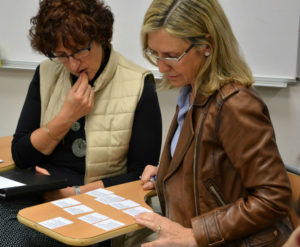Using Creativity in the Classroom
In-house teacher training
This course is also available online
1 week
Course Length
Flexible
Lesson Days
15
Lessons
English
Language
B1
Minimum Level
Overview
The “Using Creativity in the Classroom” course is designed for experienced English teachers who are working with primary, secondary schools and adult students. The course helps the teachers to be more creative in teaching English, helping the students to improve their English throughout language games, music, songs, art, drawing etc.
You will learn a specific skill set in order to boost more creativity in the classroom, you will be able after the course to prepare students for their learning beyond the classroom by engaging them through creative concepts which tend to let the students retain more from the lesson and boost their self-esteem and sense of achievement.
The course methodology takes into account new learning trends and theories, as well as (creatively) revisiting some well-established ones; this will bring you to learn how to generate and exploit creative grammar, skills and vocabulary activities by blending a wide range of learning materials with the life knowledge your learners bring to class.
Completing this course will help you:
- To experience and design creative activities
- Experiment with new trends in language teaching to promote creativity
- To explore creative uses of authentic materials, visuals, realia and ICT resources
- To extend your own repertoire of engaging and motivational class activities.
Who is the course for?
For teachers who want to will learn a specific skill set in order to boost more creativity in the classroom.
Course Sample programme
| Week 1 | Course Content |
| Day One | Experiment with new trends in language teaching to promote creativity |
| Day Two | Explore creative uses of authentic materials, visuals, realia and ICT resources |
| Day Three | Experience and design creative activities |
| Day Four | Engaging and motivational class activities |
| Day Five | Review and Feedback |
*Please note that the course content may be subject to change due to latest methodology trends updates. 1 lesson=45mins
Share This Class:
What people are saying



In-House Training
You might also be interested in these courses

Supporting pupils with Special Educational Needs and Disabilities
This course develops the skills of those involved in the education of pupils with Special Educational Needs and/or Disabilities (SEND) so that these children…

Higher Order Thinking
Developing Higher Order Thinking requires teachers to establish with their student a knowledge base of thinking skills, reasoning, critical thought, and problem-solving…

Scaffolding
With our workshop “Scaffolding” you will understand in more details on how to support second language learners by providing helpful hints to help students…
More Courses in the UK, Ireland and Malta
You might also be interested in these courses

Technology for Language Teachers
Technology for Language teachers is aimed at teachers who want to use more technology in the classroom to enhance the learning experience of their students…

Teaching for Exam Classes
Teaching for Exam Classes is for English teachers who are preparing teenage or adult students for exams. Preparing to teach Cambridge or IELTS exam class. London…

Pronunciation and Performance with an expert “Adrian Underhill”
Pronunciation and Performance with an expert is a course led by a world-renowned ELT Consultant and Trainer. Adrian Underhill is an author and the series…
Methodologies

Total Physical Response
Total Physical Response is considered to be an excellent way of learning vocabulary. Moreover, since it is based on commands, the students can easily learn the meaning of the words in the target language.

The Structural Approach
This method is based on the opinion that it is imperative to understand the structures of the language. Understanding the complexities of the structures of the sentences in a language is more important than learning the vocabulary of the language.

The Direct Method
This method primarily focuses on the development of oral skills. One of the most important characteristic feature of this method is that visual materials and real-life objects are used. Moreover, such an oral training helps in reading and writing. There is no translation involved in this method.
